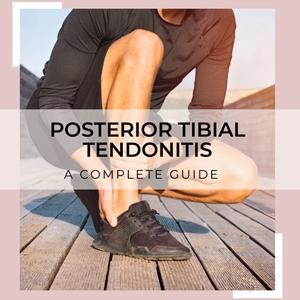Posterior tibial tendonitis is one of those pesky injuries that can really mess with your training regimen. It is a condition that affects the posterior tibial tendon, located on the inside of your ankle. This tendon helps to support your arch and heel, so when it becomes inflamed or irritated, you may experience pain, inflammation, and difficulty walking. If you're experiencing these symptoms, don't panic! This guide will teach you everything you need to know about posterior tibial tendonitis, including causes, treatment.
Causes & Symptoms
The most common cause of posterior tibial tendonitis is overuse—excessive running, jumping, and other activities that put stress on the muscles and tendons that support the ankle. This can cause inflammation of the tendon, which leads to pain and swelling in the back of the ankle.
The signs and symptoms of posterior tibial tendonitis include aching pain along the inside of your shinbone, weakness in your foot and ankle muscles, swelling around your inner ankle, and difficulty flexing your foot.
Treatments
The best way to treat posterior tibial tendonitis is by taking a break from the activities that might have caused it in the first place. As you rest, use an ice pack on the area for 20 minutes every few hours. You should also elevate your leg whenever possible to reduce swelling and pain. Wearing an ankle brace with a compressive sleeve during your recovery will stabilize the tendon while you walk and allow it to heal. Severe cases of tendonitis will require complete immobilization in a cast or walking boot.
We also use laser therapy to cut patient’s recovery time in half. Yes, you heard that right!
Our FDA-Cleared Class IV MLS Laser uses concentrated light energy to stimulate the body’s own healing process to minimize pain, inflammation and promote healing. Most patients feel a 75% reduction in pain after just six laser treatments performed in two weeks.
Stretching and strengthening exercises can also help reduce pain and improve mobility. Start with gentle stretching of your calf muscles to help increase flexibility. You can also try isometric exercises, which involve contracting the muscles in your foot and ankle without moving them. As you get stronger, you can graduate to closed kinetic chain exercises that involve movement of your foot and ankle.
After stretching, use a topical anti-inflammatory called Mod Pod Soothe, to reduce any inflammation. Soothe is a pain-relieving stick that contains 1000mg of CBD, arnica, eucalyptus, and lavender oils. This ultra-potent combination will reduce pain for a minimum of 4 hours.
If you’re experiencing any of the symptoms we’ve outlined, please call us at 859-264-1141 or schedule an appointment online as soon as possible. We want to help get you back on your feet and enjoying life again. In the meantime, be sure to stay off of your feet as much as possible and ice the area regularly. And don’t forget – our blog is always here for you when you have questions about posterior tibial tendonitis or any other foot/ankle injury or condition.

